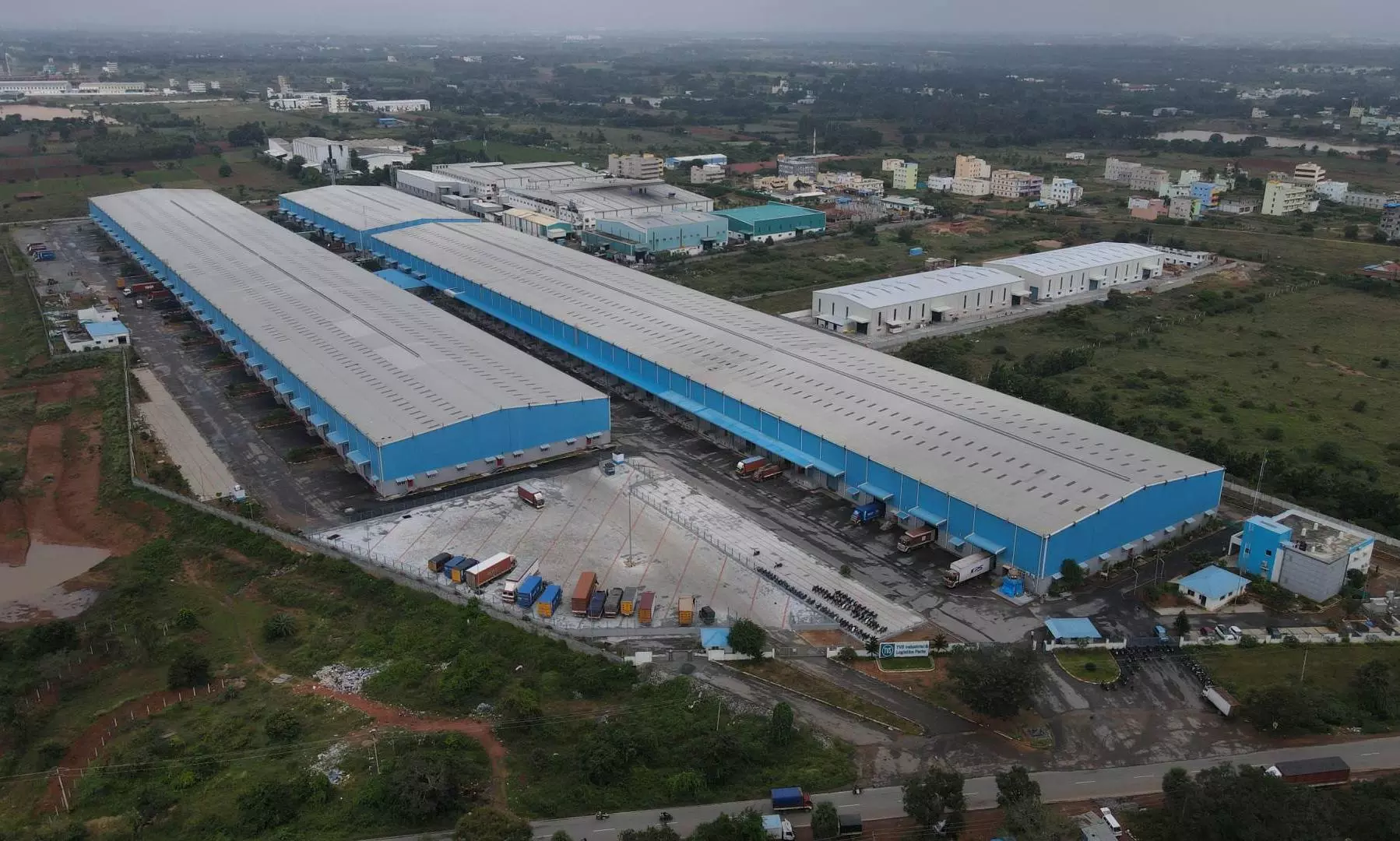Northeast India: Next frontier in TVS ILP’s expansion

Image: TVS ILP Hosur Park 1 Credit: TVS Industrial & Logistics Parks (TVS ILP)
The Indian logistics park developer TVS ILP is getting into a new phase of growth and they are looking at the eastern and northeastern regions as their next frontier. However, there are challenges in land acquisitions and evolving market demands await them.
“Now we are focusing on Siliguri in Sikkim and Guwahati in Assam. We are strong in South India and from the southern region we want to move to the eastern region of India and that's where our primary focus is now.”
These are the words of Manikandan Ramachandran, the chief operating officer of the logistics parks developer TVS Industrial & Logistics Parks (TVS ILP).
He is forecasting a million square feet (sq ft) warehousing space demand in both cities while the company is aggressively looking for land acquisition, which comes with challenges that are unique to northeastern states.
“From a demand perspective, Siliguri has a focus on FMCG and e-commerce along with the good presence of pharma companies in the region while Guwahati is still driven by demand from third-party logistics (3PL) companies, FMCG and e-commerce,” he said.
The Indian warehousing market is expected to reach ₹2,872 billion by 2027, expanding at a CAGR of ~15.64 percent during 2022-2027, according to Research and Markets. TVS ILP is a significant player in this market with 10 million square feet (sq ft) of warehousing space across 18 facilities in 11 Indian cities. The warehousing space provider plans to expand its portfolio to 13 million sq ft by the end of the next fiscal and to 20 million sq ft in 41 cities by 2027. The company intends to achieve this by developing a warehousing facility close to the consumption and demand centre in every 400 kilometres of the length and breadth of the country, as briefed by Ramachandran.
“Supply chain is not about Tier 1 or Tier 2 cities but the location advantage.”
Manikandan Ramachandran, TVS ILP
The company attracted investors and investments in the past year which includes $100 million in three phases from NIIF Infrastructure Finance (NIIF IFL) in August 2023 and in the form of Lingotto, an investment management company owned by Dutch holding company Exor controlled by the Agnelli family, which was onboarded with a 21 percent shareholding in TVS ILP, at an enterprise value of ₹2,800 crore.
Ramchandran said, “We will spending ₹1500 crore annually which will give us five million sq ft of space. Even though contracted revenue for this five million will be achieved in phases, we are expecting ₹100 to ₹120 crore per year.”
Along with the investments, the company is swiftly developing and expanding facilities for new and existing clients in different cities. For instance, In June 2023, TVS ILP handed over a customized 1.31 lakh square feet warehouse to the multinational food and beverage company Nestlé along the Palladam-Cochin Road in the Sulur area of Coimbatore. Designed to meet Nestlé’s specific requirements as a specialised cold storage unit and positioned within the Sulur Warehousing Cluster, the facility could help Nestlé serve customers in the surrounding areas and the South Indian market.
Meanwhile, in September 2023, TVS ILP broke ground on a new 570,000 sq ft warehouse in Pillaipakkam, Chennai to support the close by manufacturing facility of US-headquartered solar technology and manufacturing company First Solar. It will serve as a staging area for First Solar’s raw materials and inventory.
And more recently, in January 2024, TVS ILP signed a Memorandum of Understanding (MoU) with the Goa Investment Promotion & Facilitation Board (Goa-IPB) for the development of a Grade A Logistics & Warehousing Park spanning an area of 15-20 acres with an investment of ₹125 crore in the Verna Industrial Estate. TVS ILP has also delivered or executing new projects in Madurai, Vijayawada and Sri City, while lands are acquired in Vizag and Cuttack.
“Up to Cuttack, we are already present. We have the land and the construction is going on. Siliguri and Guwahati are work in progress,” as Ramachandran puts it.
Traditionally, there has been a very good presence of Grade A facilities in North, South and West of India. East is still catching up. The eastern region is the most underserved market in the country today.
The East is also improving a lot in terms of consumption. We want to be a forerunner and have the first-mover advantage.
The expansion plans to the Northeast are also not without any challenges. For instance, Ramachandran points out that land acquisition in this region is one of the toughest challenges.
“Land is a big barrier in the Northeast. It is not an easy play for anybody. Finding clean land is difficult in these northeastern regions. Cost-effective lands are even more difficult. However, we have got very good inquiries from FMCG.”
While east and northeastern remain a focus for TVS ILP, what remains striking is the choice of cities for the company to develop Grade A facilities and most of them are not Tier 1 or Tier 2 cities.
To which Ramachandran responds, “Supply chain is not about Tier 1 or Tier 2 cities but the location advantage.”
For instance, he took the example of the city Madurai, where by setting up a warehouse the companies can cater to the entire south of Kerala, because of good road connections, and the south of Tamil Nadu.
“Since there was no Grade A facility in the city, there were no plans from the end users. Once we started the facility, many people started to move out of the nearby markets like Salem because they understood they could be closer to the consumption markets.”
He also pointed out that there is a trend among their clients and companies to move away from Tier 1 cities and set up warehouses in strategic locations because of the rental advantage as well as their proximity to consumption markets.
“We got the first mover advantage in cities like Hosur, Madurai and even Vijayawada. This put us ahead of the curve.”
He also delved deeper into the reasoning behind developing warehousing facilities very early on in the rather remote Karnataka-bordering town in Krishnagiri district of Tamil Nadu, 40 km away from Bengaluru city.
“Hosur is in close proximity to Bangalore and has been an auto manufacturing location. TVS ILP already had a strong presence of its group companies in Hosur, particularly with the manufacturing sites of TVS Motor Company,” he said.
One of the key attractions he mentioned was leasing-related cost benefits, particularly for e-commerce companies compared to the high real estate prices in Bengaluru. “Real estate prices were nominal in Hosur.”
He added, “Manpower, especially skilled manpower, is very easy to find in Hosur. The city is also equipped with infrastructure that enables easy connectivity to other parts of the country and it sits very close to the demand points.”
Due to the changing nature of businesses among clients and their renewed requirements from logistics parks, Ramachandran thinks it is time for Grade A warehouses to change their definition.
“All industries are going through a churn including the logistics sector. Earlier, clients used to specify four to five focus areas under the Grade A requirements. However, now when we get a spreadsheet from our customer, it will have 100-150 parameters. Feel like it's time to revisit the definition of Grade A warehouses. So that we revise Grade A to a new benchmark,” he said.
This article was originally published in Indian Transport & Logistics News' Mar-Apr 2024 issue.

Libin Chacko Kurian
Principal Correspondent at STAT Media Group, he has six years of experience in business journalism covering food & beverage, nutraceuticals and now logistics. His current passion is to understand the nuances of global supply chains and their current turmoil. Outside work, he is also interested in philosophy, history, birding and travelling. Mail him: libin@statmediagroup.com Follow on LinkedIn



